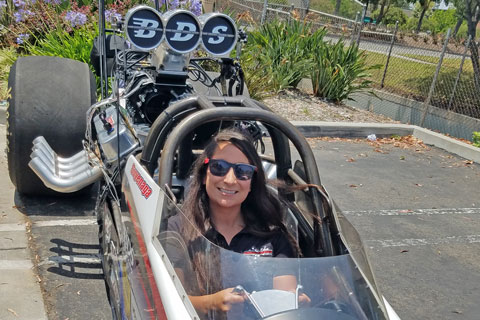PEOPLE
Servant Leader
Three Decades of Helping the Industry Grow and Prosper
By John Stewart
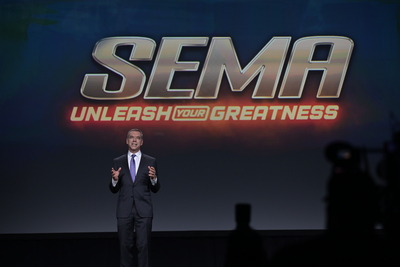
After 30 years of service to SEMA and two decades as the association’s president and CEO, Chris Kersting retired, effective February 1.
Growing up in Ohio, Chris Kersting had five older brothers, “and they were all bigger than me,” he recalled. One morning as he played outdoors with the older boys swinging on vines, he fell and broke his wrist, earning a trip to the hospital. Returning that afternoon with a cast, he again joined his brothers, this time climbing onto a platform in an apple tree. When he got knocked off the platform, he broke the other arm and went right back for another cast. “I think the same shift was still on at the hospital,” he laughed.
It’s not everyone who breaks both arms in a single day. But it’s an incident which suggests that, from a young age, Kersting was never the kind of guy to be deterred just because he got banged up a little. That degree of tenacity was one of the qualities that became evident during Kersting’s 30-year service to SEMA. That service ended February 1 upon his retirement.
Looking back across those decades provides insights into a time of growth for the industry and the association—and into the nature of Kersting’s leadership.
Flash forward to 1989: Young Kersting had graduated from law school and was looking for work. At the time, Russ Deane was a partner in a law firm based in Washington, D.C., serving as general counsel to SEMA.
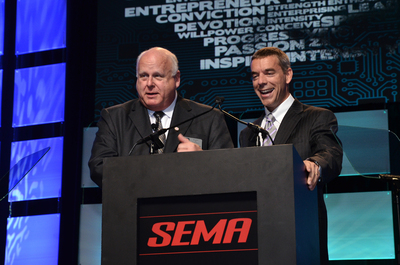
Paul “Scooter” Brothers, shown here in 2011, worked closely with Kersting on a number of projects, including the acquisition of the Performance Racing Industry organization. “We really enjoyed some of that stuff we got to do together,” Brothers said. “He’s just a special person. He was there when you had to recognize that it was a special time, you had to reach out and work harder, longer, stick your neck out more. And he did that stuff with the conviction that he knew he had everything in line to pull it off, and he always did.”
“I walked into an interview, sat down, and on the other side of the table was Russ Deane,” Kersting recalled. “I certainly didn’t know that this was the beginning of a road that would last 30 years, working with the companies and the great people in this industry. But that was a fateful day.”
Deane’s recollection of that interview is that he didn’t think he needed any additional help at the time and was unlikely to hire anyone. But after he met with Kersting, he changed his mind.
“What I saw was this innate talent, the intellectual capacity to think through things and deal with difficult questions—and deal with them in a very sophisticated fashion,” Deane recalled. “I said to my partners after the initial interview, ‘We’re hiring this guy.’”
Deane moved quickly to monopolize the time of young Kersting and began to load him with a wide variety of projects.
“Over the years, we dealt with very difficult issues involving a lot of complexity and a lot of technical detail,” Deane said. “Chris thrived on that, and over time, that became obvious to others—especially at SEMA.”
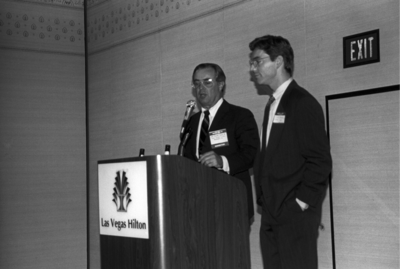
Russ Deane (left) hired Kersting right out of law school, circa 1989, when Deane was serving as general counsel for SEMA.
Revving Up the Washington Office
“After a period of time, it became clear SEMA needed its own Washington office to handle the onslaught of regulations confronting the industry,” Deane said.
“I enjoyed what we were doing,” Kersting recalled, thinking back to 1996. “I’d figured out that this was my passion. SEMA members were like David in front of these huge government Goliaths—the U.S. EPA [Environmental Protection Agency], NHTSA [National Highway Traffic Safety Administration], the California Air Resources Board [CARB], and all the state regulators. It was challenging, but we were making a real difference for the people in our industry. In the course of all of this, SEMA President Chuck Blum asked me to join the association as vice president of government affairs; it was a pretty natural transition.”
When Kersting came on as a SEMA employee, he found that he had his work cut out for him.
“Challenges in the legislative and regulatory arena were in many ways similar to today’s, but also different,” Kersting recalled. “We had federal issues, but the states were much more active then with unresolved safety regulations. I cut my teeth on federal lawsuits challenging the EPA’s proposed on-board diagnostic (OBD) regulations [work that ultimately secured the right for SEMA manufacturers to access and modify OBD programming]. Yet it was the state governments that were causing a lot of the grief for the SEMA marketplace.”
That required SEMA to build out a monitoring-and-response capability in all 50 states—no simple task in the pre-internet era.
Deane recalled that time: “Noise control was a big deal. In California, the cops would use noise control as a way of harassing hot rodders. We faced similar issues with raised and lowered vehicles and a range of lighting issues. Chris and SEMA’s D.C. team lined up a reliable monitoring network and basically went state to state to convince lawmakers to adopt SEMA’s model regulations.”
They launched a grassroots partnership with car clubs and enthusiasts nationwide (the SEMA Action Network) to raise a voice to support the industry’s efforts—things that really gave the industry the chance to grow.
During those days, Kersting became more visible in the association, regularly attending SEMA board meetings.
“They got to know him and his capabilities,” Deane said. “He demonstrated all the characteristics that most people would find important in a CEO.”
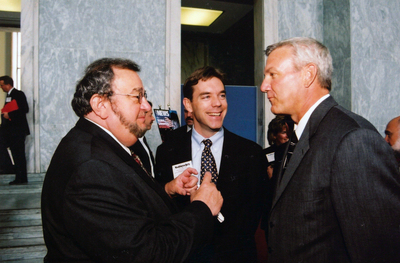
After a time Kersting was asked to become a SEMA vice president and run the Washington, D.C., legislative affairs office. Kersting, shown here with then-president Chuck Blum (left) and race-car driver Dale Jarrett (right), was instrumental in setting up the lobbying opportunity for SEMA members that later became the Washington Rally.
Entrepreneurial Man in the Middle
Kersting took the handoff from Blum in 2002. As SEMA’s president and CEO, he found himself managing a growing professional staff located in Diamond Bar, California, and serving at the pleasure of the board of directors, which turned over every few years. It meant that he had to work closely with the chairman of the board, the board members themselves, and also maintain a strong relationship with his own team in the Diamond Bar headquarters.
“That’s a tough position, being in the middle,” said Nate Shelton, who was the first board chairman Kersting worked with when he assumed the CEO leadership role. “He was always really good that way. He knew that his job was not necessarily to handle us but to put in place the things we asked him to do. And that’s really hard to find in somebody.”
Shelton was one of 10 different chairmen Kersting worked with spanning his 20 years as CEO. Corky Coker was another.
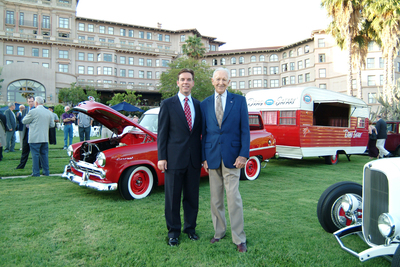
Even before he joined SEMA, Kersting worked with Deane for clients that included the National Hot Rod Association (NHRA). He became fast friends with many NHRA directors, including founder Wally Parks (right).
“I got to know Chris very well during those early years,” Coker said. “I have always admired his energy, his integrity, his commitment to his family, and his love for whipping things up to a place of success. Despite the fact that he has been for these 30 years a ‘recovering attorney,’ he still has always had an entrepreneurial energy and sense about him.”
Shelton, who served in two different decades as SEMA board chairman, had the opportunity to witness Kersting’s bent for business across a lengthy period of board service. He saw Kersting taking up opportunities and seeing them through.
“I thought he was very sharp, really a bright guy, to the point where he could make choices and decisions,” Shelton said. “I thought he was very good at that. He wasn’t puffed up—and he didn’t think that just because an idea wasn’t thought of here, it wasn’t any good.”
“Chris was involved when we started the SEMA Garage,” Shelton said. “We recruited [SEMA Interim Co-CEO] Mike Spagnola, who was finishing up on the board at the time, to head that one up. Chris was also on the forefront of buying PRI [Performance Racing Industry]. I was chair-elect, and Chris was really instrumental in accomplishing that.”
Kersting remembered that time vividly.
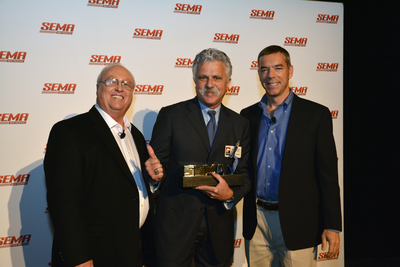
The first chairman to work with CEO Kersting was Nate Shelton (left), who served two terms as chairman many years apart. Next came Corky Coker (center) who recalls working so smoothly with Kersting that “we could finish each other’s sentences.”
“I became aware that there might be an opportunity with PRI,” he said, “but the matter needed to be kept confidential.”
Kersting worked closely with then-Chairman Paul “Scooter” Brothers, who arranged the initial meeting.
“Having Scooter involved as chairman at the time and tapping the relationships he had on the racing side, that was a key factor,” Kersting recalled.
When the time was right, the two brought the opportunity to the larger board, and eventually a decision was made.
“It took us about a year, but we ended up buying it,” Brothers said.
Next, it became apparent that it would be ideal if the PRI Trade Show could move from Orlando, Florida, back to Indianapolis, relieving the racing community of the need to attend two similar trade shows just weeks apart. The Indianapolis show, known as IMIS [International Motorsports Industry Show], had become a legitimate competitor to the PRI Trade Show by that time.
“Chris and I went to Indy and met with the IMIS owners, and we ended up putting that together,” Brothers said.
Then yet another obstacle arose: “Moving the PRI Trade Show back to Indy was the easy part—the hard part was moving it without financial setbacks for leaving Orlando,” Brothers said. “Chris did all the behind-the-scenes stuff that had to be done, and the fact that he is an attorney probably kept me out of trouble, because we were spending a lot of somebody else’s money. So this is Chris Kersting, who has this ability to look into the future and say, ‘There’s an opportunity,’ and to go get it done.”
To hear Kersting tell it, the ability to foresee problems and opportunities came with his vantage point as SEMA’s CEO.
“It afforded me the chance to see and collect a lot of information as the association went about its work,” he said. “We had a great team of colleagues at SEMA and on the board who were doing the same thing.”
True enough, but perhaps just as important was that the people he was in touch with trusted him, even with information that had to remain strictly confidential. Then too, he was very good at connecting the dots.
“It was important to sift through the information to see what challenges and opportunities were apparent there,” he reflected. “This helped us to conceive and deliver innovative services such as the SEMA Garage, the emissions lab and certification assistance program, and the SEMA Data Co-op [now known as SEMA Data].”
Scooter Brothers put it this way: ‘The board was his boss, but Chris was the one who stayed out in the marketplace and was able to recognize an opportunity, bring it back to the board, and let the board think it was their idea.”
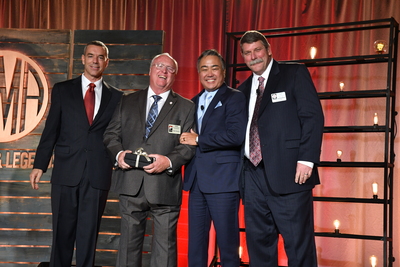
Kersting supported 10 different board chairmen during his tenure as president and CEO; among them were (left to right) Nate Shelton, Wade Kawasaki and Doug Evans.
Evolving the SEMA Show
One of the important developments during Kersting’s early years was the expansion of the SEMA Show beyond the walls of the exhibit halls.
“We stuck our necks out a bit with that one,” Kersting remembered. “The cardinal rule was that you didn’t take buyers off the Show floor, you didn’t take them away from the exhibitors.”
Many in the industry were adamant about that, but Kersting persisted and was ultimately persuasive.
“We began adding opportunities around the perimeter of the Show for the industry to celebrate the automotive culture,” recalled Wade Kawasaki, a past chairman who has known Kersting for more than two decades. “In the boardroom, that was a very bold stance for Chris to take, and it’s one that has benefited us in amazing ways over the years.”
A particularly big moment came when DUB Co-Founder Myles Kovacs proposed a DUB event outside the South Hall. When Kovacs faced stiff board headwinds on the matter, Coker recalled that “Chris just made sure everyone was heard and continued on, showing that the more we bring to the Show and the more we make this thing bigger, badder and better, the more the buyers will show up.”
“We were a team that was inspired to make changes,” Kersting noted. “Bill Miller [SEMA interim co-CEO], Peter MacGillivray [previous SEMA vice president of events], Tom Gattuso [SEMA vice president of events]—these were talented instigators and facilitators for these changes.”
Paving the way for later additions such as SEMA Cruise, SEMA Ignited, Battle of the Builders and Launch Pad, the Show today provides platforms in a digital world that allow people to share the industry’s incredible automotive content with enthusiasts all over the planet.
“That attracts a lot more young people, “Kawasaki observed, “and that’s a really important thing to do to keep our industry viable.”
In the end, Kersting observed, “Breaking the old rules allowed us to take the SEMA Show from being a highly valued business-to-business market event to also becoming a mecca for automotive culture.”
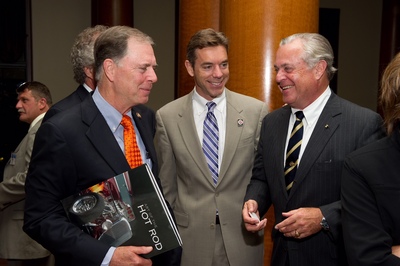
Very much in his wheelhouse at the Washington Rally, Kersting (center) and Russ Deane (right) enjoy a moment with Rep. Bill Posey (R-FL).
Growth and Challenges
Kersting had the good fortune to lead across a period of growth and opportunity for the automotive specialty-equipment industry, but he also led through times of difficult challenges.
Through any given time, there is a multitude of factors that lead to progress, including hard work by numerous individuals at all levels, but there is no question that Kersting’s time with the association marked a period of rapid growth for both the association and the industry.
Association membership, just a tad over 2,400 when Kersting started, grew steadily during his tenure and tops 6,463 member companies today. The industry as a whole expanded from $15 billion in 1994 to $48 billion as of 2020, and notably, the SEMA Show enjoyed conspicuous growth during his tenure.
“It’s a delicate tightrope for a leader who works for companies governed by a board of directors,” Coker observed. “But Chris did bring us into making our event a worldwide draw.”

As leader of the SEMA staff, Kersting made it policy to carve out employee-appreciation events, where he and the leadership team would wash the cars of other employees, or cook up parking-lot picnic lunches. At the car wash event, a water-balloon war was certain to break out.
On the challenges side: “When 9/11 hit us, we had to make a big decision, because there were a lot of people who didn’t want to have the Show,” Shelton recalled. Ultimately, the Show went on, even though air travel was restricted and attendance was lower than usual. “But it built up every year after that—and it just kept growing and growing. I think that had a lot to do with Chris and what he did for SEMA.”
Another period of challenge came in 2008, when the Great Recession took hold. Jim Cozzi was chairman at the time and recalled the situation.
“It was an unprecedented time for the auto industry, the organization and the Show,” he said. “We just didn’t know what was going to happen. Up until that point, I don’t think SEMA ever had to go into a budget cycle and make cuts—but we did then. And we helped the industry get the SEMA Show accomplished over a couple of tough years. Those were difficult times for Chris, myself, and everybody on staff. But he did what he had to do, and it was best for the association.”
These early trials were good preparation for what would come later: a pandemic the likes of which the modern world has never known. As SEMA Vice President of Events Tom Gattuso noted, the job of president and CEO “takes on a different life during times of turmoil, and coming out of 9/11, getting through the financial crisis, [holding a Show] 30 days after the shooting at Mandalay Bay, going through COVID and having to cancel the Show for the first time in 54 years-—those are the types of things where Chris really had to take the things he had learned and lead the association through them.”
The COVID pandemic, in particular, created huge challenges for the industry and especially trade shows, including SEMA and PRI. As convention venues shut down in 2020 and large, in-person gatherings became impossible, the association staff quickly shifted toward creating a virtual meeting place to serve SEMA members’ needs. That effort may have worked for some people, but not the vast majority of SEMA members, who have come to rely on face-to-face meetings to do business.
The following year, with COVID restrictions reduced, a successful Show was held in Las Vegas, but not without coping with numerous unknown variables and shifting circumstances.
“In the weeks leading up to the 2021 Show, we had to remap the floor every night,” Gattuso recalled.
In order to accommodate changing plans among exhibitors and vendors, new foot-traffic patterns and safety precautions had to be developed.
“Producing a Show in 2021 in Las Vegas and following that up with PRI, those were two of the most challenging experiences we’ve ever had,” Kersting recalled.
But in the end, buyers and sellers had the opportunity to meet face to face once again, and the SEMA Show turned out to be the largest and most successful trade show gathering in America during the pandemic.
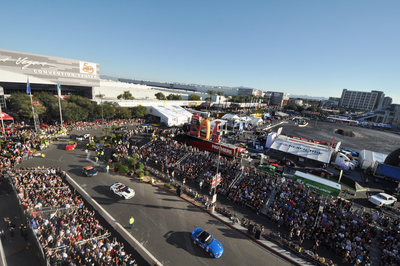
Over the years, Kersting was an advocate of adding lifestyle features to the SEMA Show, like the SEMA Cruise. The result was greater public awareness of the automotive aftermarket, and increased attendance at the Show.
Executive Leadership
Among the staff and others in the industry, Kersting is thought of as an exceptionally hard-working, well-prepared executive who is capable of grasping the big picture and fine detail at the same time. Gattuso put it this way: “The thing about Chris is that he’s got his finger on the pulse of every business unit that we have. Because of that, you might think he doesn’t understand your business unit until you’re in a meeting with someone and he explains it better than you could have explained it yourself. I came to SEMA with 15 years of experience doing events. Chris is not an event guy by background, but he understood how events work, how they can be successful, and he became someone I realized I could learn from.”
Kersting has also been described by more than one associate as a servant leader.
“Chris is a pretty humble guy,” said Spagnola. “Humble in nature, he makes sure everybody gets to share in the glory.” Recalling that the vast majority of SEMA-member companies have fewer than 10 employees, Spagnola observed, “Chris is always looking out for the little guy and making sure he gets a fair shake. He always thinks, ‘What would our members want?’”
SEMA Interim Co-CEO Bill Miller is among those who has worked for Kersting for more than a decade.
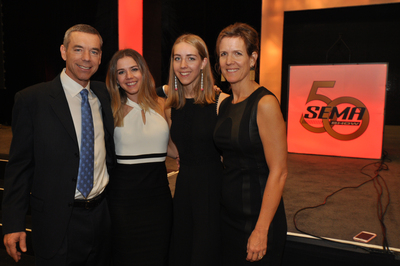
A devoted husband and father, whenever possible Kersting brought his wife Lisa and their two daughters along for events that required him to be away from home.
“Chris was the epitome of a great player-coach,” Miller said. “As leader of the team, he set the tone and articulated the ‘what’ and ‘why’ messages better than anyone I know. Then, when needed, he’d be there in the trenches, working alongside us creating opportunities, solving problems and delivering benefits to our members.”
And then there is Kersting’s way of motivating staff and inspiring commitment.
“With Chris, we see this passion for what he does,” said SEMA Councils and Membership Vice President Nathan Ridnouer. “It’s not just that he doesn’t give up, like a bulldog, it’s that he loves it. He loves every conversation. He loves the nuance of it. He doesn’t just check the box to call something ‘done.’ I have never seen him check the box and not care. Chris has been an approachable leader whom people also look up to.”
Outside of work, Kersting is an avid back-country guy, enjoying all endeavors involving a dirt trail. At 60, he’s still on the steeps weekly with his mountain bikes, and to replenish the calories, he is an experienced brew master, crafting beer at home since 1987.
“I have friends who enjoy sending me pictures of themselves when I am out of town, standing at my patio brew tap and pouring themselves a cold beer,” he said.
Those friends may have a harder time raiding Kersting’s kegs now that he will have more time at home and hearth. He has been married to wife Lisa for some 35 years, and they have two daughters, now grown and out of the house.
“It gets tough for a man in his position,” Cozzi observed. “But with Chris, his family was always first—Lisa and the girls. I guess it might not seem that way from the outside, but I spent a good portion of two years with that guy.”
Kersting would be the first to credit Lisa for her support over the years, when he worked long hours and spent many days on the road developing opportunities and guiding the association.
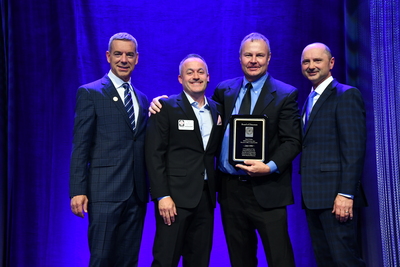
Kersting with SEMA Chairman James Lawrence (second left), SEMA Chair-Elect Kyle Fickler (second right) and SEMA Immediate Past Chairman Tim Martin (right) at the 2021 SEMA Installation Gala.
Kersting’s tenure as president and CEO was completed at the end of January, and he has transitioned into an advisory role through July 2022. SEMA executives Bill Miller and Mike Spagnola serve as interim co-CEOs as the association moves to select a new president. Both have broad experience and extensive contacts, logging many years in the association serving the industry.
“The selection of the new president is going to be really tough,” Brothers observed. “Chris was the perfect man at the perfect time who took SEMA from almost a club to something that now has serious international clout. In a relatively short period, it changed from a good guys little network and grew and grew to something that is now run like a real business and has pretty good assets—and a pretty good chance to move to the next level.”
Many board members, past and present, look back on the association’s years of growth with appreciation for Kersting’s efforts. Current Chairman of the Board James Lawrence put it this way: “Over the past 30 years, Chris has lived his life dedicated to making an impact in the automotive aftermarket. SEMA and the entire automotive aftermarket are lucky to have had someone as talented at the helm. There were many situations over the years that needed his steady hand, through emissions challenges and economic headwinds. In recent times, Chris successfully worked with the SEMA board to start the process of transforming the association into being more consumer-focused, and he supported both the PRI acquisition and the drive toward supporting the motorsports community through the PRI association. Chris retires having left quite a ding in the automotive universe.”


